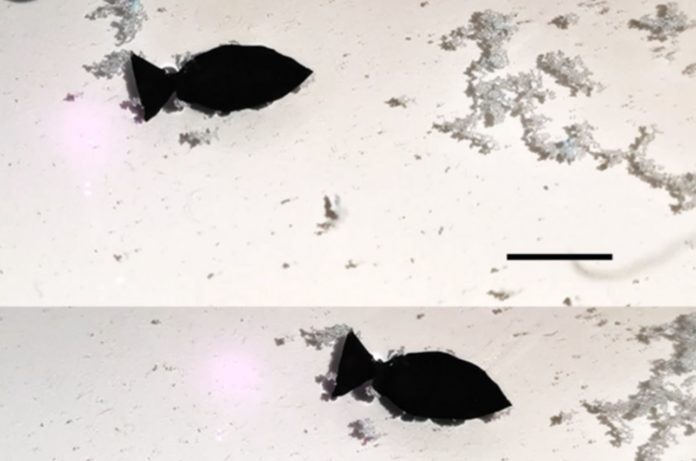Microplastics are present almost everywhere on the planet and can be dangerous to animals if consumed. But once they find their way into the crevices at the bottom of rivers, it is difficult to get rid of such tiny particles from the ecosystem.
Researchers have now developed a light-activated fish robot that “swims” fast across the surroundings collecting and eliminating microplastics from the environment, according to ACS’ Nano Letters.
Microplastics are hard to get rid of from water because they can get stuck in cracks and holes. One suggestion is to access these toxins and clean them up using small, flexible, self-propelled robots.
But hydrogels and elastomers are the usual materials for soft robots, and they can be easily damaged in water. Mother-of-pearl, also called nacre, is a strong and flexible material that is found on the inside of clam shells.
The layers of nacre have a microscopic gradient that goes from lots of calcium carbonate mineral-polymer composites on one side to mostly silk protein filler on the other side.
Inspired by the gradient structure of this natural substance, Xinxing Zhang and his colleagues sought to develop a durable and flexible material for soft robotics.
The scientists built composite nanosheets by joining molecules of -cyclodextrin with sulfonated graphene. Then, varied concentrations of nanosheet solutions were added into polyurethane latex combinations.
A layer-by-layer assembly process produced an orderly concentration gradient of the nanocomposites through the material, from which the scientists developed a 15-mm (approximately half-an-inch) long fish robot.
The robot moved forward by rapidly switching a near-infrared light laser on and off at a fish’s tail, causing it to flap. The robot was able to swim at a pace of 2.67 body lengths per second, which is quicker than other soft swimming robots previously recorded and about equivalent to the speed of actively moving phytoplankton in water.
The researchers demonstrated that the swimming fish robot could regularly absorb and transport adjacent polystyrene microplastics. Additionally, the material could self-heal after being cut while retaining its capacity to absorb microplastics.
The fish robot’s speed and endurance, according to the researchers, make it suitable for monitoring microplastics and other pollutants in challenging aquatic conditions.
Image Credit: ADAPTED FROM NANO LETTERS 2022
You were reading: This Tiny, Scary Fish Robot Collects Microplastics As It Swims
